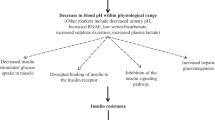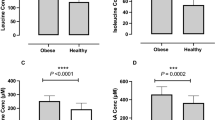Abstract
Objective:
To examine the effects of low-carbohydrate, ketogenic (LCKD) and low-fat (LFD) diets on acid-base status.
Design:
Prospective analysis of volunteers from two clinical trials.
Participants:
Subset of 39 volunteers from a randomized trial comparing the effects of an LCKD with an LFD, and a single-arm trial of an LCKD.
Setting:
Outpatient research clinic.
Intervention:
LCKD (initially <20 g of carbohydrate daily) or LFD (<30% of energy from fat, 500–1000 kcal energy reduction) instruction.
Measurements:
Arterial blood gas analysis, serum chemistries (electrolytes, urea nitrogen/creatinine, glucose, ketone bodies, lactate), anion gap, and urine ketone bodies measured at weeks 0, 2, 8, and 24.
Results:
Participants had a mean (±standard deviation) age of 43.5±9.3 years; 28 (72%) were female, 29 (74%) were Caucasian. Using linear mixed-model analysis to examine blood test changes from baseline to 24 weeks, the LFD group experienced a decrease in arterial blood pH from a mean of 7.43 at week 0 to 7.40 at week 24 (P=0.03), and the LCKD group experienced a decrease from 7.42 at week 0 to 7.40 at week 24 (P=0.01). The lowest pH measurements observed were 7.34 in the LFD group and 7.37 in the LCKD group. Although serum bicarbonate appeared to decrease from baseline at weeks 2 and 8 in the LCKD group, the change at 24 weeks was not statistically significant in either diet group, and only four of 131 (two of 92 from the LCKD group) measurements were less than 22 mmol/l. The proportion of participants with elevated urine and serum ketone body levels rose in the LCKD group only, was highest at week 2, and decreased over the subsequent time points.
Conclusion:
In individuals following an LCKD or an LFD, blood pH decreased mildly and the LCKD group experienced a small, transient decrease in serum bicarbonate in conjunction with mild ketosis. This suggests that an LCKD induced a mild compensated metabolic acidosis, but no individual showed evidence of significant metabolic derangement.
This is a preview of subscription content, access via your institution
Access options
Subscribe to this journal
Receive 12 print issues and online access
$259.00 per year
only $21.58 per issue
Buy this article
- Purchase on Springer Link
- Instant access to full article PDF
Prices may be subject to local taxes which are calculated during checkout


Similar content being viewed by others
References
Anonymous (2000). The practical guide: identification, evaluation and treatment of overweight and obesity in adults. National Institutes of Health, National Heart, Lung, and Blood Institute, North American Association for the Study of Obesity, U.S. Department of Health and Human Services. Public Health Service: Bethesda, MD.
Anonymous (1994). Step by step. Eating to lower your high blood cholesterol. American Heart Association, U.S. Department of Health and Human Services, Public Health Service, National Institutes of Health. National Heart, Lung, and Blood Institute: Bethesda, MD.
Atkins RC (1998). Dr. Atkins' New Diet Revolution. Simon & Schuster: New York!
Azar GJ, Bloom WL (1963). Similarities of carbohydrate deficiency and fasting. II. Ketones, nonesterified fatty acids, and nitrogen excretion. Arch Intern Med 112, 338–343.
Boden G, Sargrad K, Homko C, Mozzoli M, Stein TP (2005). Effect of a low-carbohydrate diet on appetite, blood glucose levels, and insulin resistance in obese patients with type 2 diabetes. Ann Intern Med 142, 403–411.
Brehm BJ, Spang SE, Lattin BL, Seeley RJ, Daniels SR, D'Alessio DA (2005). The role of energy expenditure in the differential weight loss in obese women on low-fat and low-carbohydrate diets. J Clin Endocrinol Metab 90, 1475–1482.
Brehm BJ, Seeley RJ, Daniels SR, D'Alessio DA (2003). A randomized trial comparing a very low carbohydrate diet and a calorie-restricted low fat diet on body weight and cardiovascular risk factors in healthy women. J Clin Endocrinol Metab 88, 1617–1623.
Chen TY, Smith W, Rosenstock JL, Lessnau KD (2006). A life-threatening complication of Atkins diet. Lancet 367, 958.
Cnaan A, Laird NM, Slasor P (1997). Tutorial in biostatistics: using the general linear mixed model to analyse unbalanced repeated measures and longitudinal data. Stat Med 16, 2349–2380.
Duyff RL (1998). The American Dietetic Association's Complete Food and Nutrition Guide. Chronimed Pub: Minneapolis, MN.
Hensyl WR (ed). (1990). Stedman's Medical Dictionary. Williams and Wilkins: Baltimore.
Langfort J, Pilis W, Zarzeczny R, Nazar K, Kaciuba-Uscitko H (1996). Effect of low-carbohydrate-ketogenic diet on metabolic and hormonal responses to graded exercise in men. J Physiol Pharmacol 47, 361–371.
Larosa JC, Fry AG, Muesing R, Rosing DR (1980). Effects of high-protein, low-carbohydrate dieting on plasma lipoproteins and body weight. J Am Diet Assoc 77, 264–270.
Meckling KA, O'Sullivan C, Saari D (2004). Comparison of a low-fat diet to a low-carbohydrate diet on weight loss, body composition, and risk factors for diabetes and cardiovascular disease in free-living, overweight men and women. J Clin Endocrinol Metab 89, 2717–2723.
Phinney SD, Bistrian BR, Wolfe RR, Blackburn GL (1983). The human metabolic response to chronic ketosis without caloric restriction: physical and biochemical adaptation. Metabolism 32, 757–768.
Rabast U, Kasper H, Schonborn J (1978). Comparative studies in obese subjects fed carbohydrate-restricted and high carbohydrate 1,000-calorie formula diets. Nutr Metab 22, 269–277.
Rabast U, Vornberger KH, Ehl M (1981). Loss of weight, sodium and water in obese persons consuming a high- or low-carbohydrate diet. Ann Nutr Metab 25, 341–349.
Seifter JL (2004). Acid-base disorders. In: Goldman L, Ausiello DA (eds). Cecil Textbook of Medicine 22nd edn W.B. Saunders: Philadelphia. pp 688–695.
Shah P, Isley WL (2006). Ketoacidosis during a low-carbohydrate diet. N Engl J Med 354, 97–98.
Volek JS, Sharman MJ, Love DM, Avery NG, Gomez AL, Scheett TP et al. (2002). Body composition and hormonal responses to a carbohydrate-restricted diet. Metabolism 51, 864–870.
Westman EC (1999). A review of very low carbohydrate diets. J Clinical Outcomes Management 6, 36–40.
Yancy Jr WS, Olsen MK, Guyton JR, Bakst RP, Westman EC (2004). A low-carbohydrate, ketogenic diet versus a low-fat diet to treat obesity and hyperlipidemia: a randomized, controlled trial. Ann Intern Med 140, 769–777.
Young CM, Scanlan SS, Im HS, Lutwak L (1971). Effect of body composition and other parameters in obese young men of carbohydrate level of reduction diet. Am J Clin Nutr 24, 290–296.
Acknowledgements
The authors thank Keith Tomlin, Bill Bryson, and Juanita Hepburn for assistance with data collection. Dr Yancy is supported by Health Services Research Career Development Award RCD 02-183-1 from the Department of Veterans Affairs, Washington, DC, USA
Author information
Authors and Affiliations
Corresponding author
Additional information
Guarantor: WS Yancy Jr.
Contributors: WSY conceived, designed and coordinated the study; participated in data collection; performed statistical analysis and drafted the paper. MKO and TD performed statistical analysis. ECW conceived and designed the study, provided personnel and funding for laboratory tests and facilitated recruitment of participants. All authors assisted with interpretation of the data and contributed to the intellectual content of and approved the final paper.
Appendix
Appendix
Nutritional supplement ingredients (Atkins nutritionals, Inc.)
Multivitamin formula (administered per day in 6 capsules): Vitamin A as acetate (3000 IU), vitamin A as β-carotene w/mixed carotenoids (1200 IU), vitamin C (360 mg), vitamin D-3 (400 IU), vitamin E (300 IU), vitamin B1 (50 mg), vitamin B2 (50 mg), niacin (40 mg), vitamin B6 (50 mg), folate (1600 mg), vitamin B12 (800 mcg), vitamin K (10 mcg), biotin (600 mcg), pantothenic acid (120 mg), calcium (500 mg), magnesium (250 mg), zinc (50 mg), selenium (200 mcg), manganese (10 mg), chromium (600 mcg), molybdenum (60 mcg), potassium (20 mg), inositol hexanicotinate (100 mg), choline bitartrate (100 mg), para-amino benzoic acid (100 mg), vanadyl (80 mcg), n-acetyl-l-cysteine (120 mg), pantethine (150 mg), quercetin (100 mg), boron (2 mg), grape seed extract (40 mg), green tea (80 mg). Unspecified amounts of lecithin extracts, garlic, arginine, licorice, bromelain, pantethine, spirulina, inulin, lactoferrin, bioperine, and acidophilus.
Essential oil formula (administered per day in 3 capsules): flaxseed oil (1200 mg), borage seed oil (1200 mg), fish oil (1200 mg), vitamin E (15 IU).
Diet formula (administered per day in 6 capsules): Citrin (2700 mg), chromium (1200 mcg), soy extract (9000 mg), methionine (1500 mg), L-carnitine (3000 mg), vitamin B6 (120 mg), pantethine (120 mg), asparagus (300 mg), parsley (300 mg), kelp (120 mg), spirulina (300 mg), potassium citrate (594 mg), magnesium (360 mg), L-glutamine (450 mg), Dl-phenylalanine (900 mg), L-tyrosine (450 mg), piperine (30 mg).
Rights and permissions
About this article
Cite this article
Yancy, W., Olsen, M., Dudley, T. et al. Acid-base analysis of individuals following two weight loss diets. Eur J Clin Nutr 61, 1416–1422 (2007). https://doi.org/10.1038/sj.ejcn.1602661
Received:
Revised:
Accepted:
Published:
Issue Date:
DOI: https://doi.org/10.1038/sj.ejcn.1602661
Keywords
This article is cited by
-
Ketogenic diets as treatment of obesity and type 2 diabetes mellitus
Reviews in Endocrine and Metabolic Disorders (2020)
-
Acid–base safety during the course of a very low-calorie-ketogenic diet
Endocrine (2017)
-
Low-carbohydrate diets: An update on current research
Current Diabetes Reports (2009)
-
Carbohydrate-restricted diets for obesity and related diseases: An update
Current Atherosclerosis Reports (2009)
-
Low-carbohydrate diets and performance
Current Sports Medicine Reports (2007)



